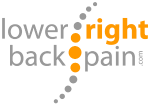Below are a list of basic low back and leg stretches to help relieve muscle tension and improve flexibility of the lower right back. You may find that certain exercises are more beneficial. We designed this menu to provide a quick well rounded stretch routine. If you are new to stretching, go slow and don't do more that one or two reps of each exercise. As you become more adapt to the stretched you can increase your stretch time and number of reps (as you feel appropriate). Remember that form is priority number one. Bad form and overstretching can lead to injury and are not recommended. Doing these stretches will help your chances or suffering from lower right back pain. Check out youTube.com for videos if you need further instruction on any of these stretches.
Knees To Chest
While lying on your back, pull one leg to your chest while keeping the other leg flat on the floor. Then raise your knees and pull both toward your chest at the same time. Hold each leg for at least 20 second stretch.
Trunk Rotation
Lie on your back with arms out to your sides. Pull your knees up toward your chest and slowly roll your legs to the side (choose one). Focus on keeping your upper body flat on the floor. Hold the stretch for 15-20 seconds then switch sides. Remember it is important to breathe and relax your muscles as you stretch.
Hip Flexor Stretch
Kneel on one knee, with toes down (use a pad if needed), and place your other foot flat on the floor in front of you, bend your knee till it is over that front ankle. Keep your head up and back straight. Press your hips forward until you feel tension in your back hip flexor and upper thigh. You can rest hands on thigh or on the side of your hips. Move your pelvis further forward to increase the stretch (you may also need to more your front foot further out). Hold for at least 15 seconds
– Imagine trying to pull (or drag your bottom knee across the floor. This should accentuate the stretch and isolate the hip flexor.
– For a more intense stretch reach your arms overhead then then to the side (away from the leg being stretched.
Hamstring Stretch
Lie on your back keep one leg straight while grabbing behind the knee of your other leg. Slowly straighten your leg and pull it toward your upper body. Ideally you will be able to bring your leg to at least 90 degrees (or straight up in the air) while keeping your other leg parallel on the ground. Hold this stretch for 15-20 seconds then repeat on the other side.
Quadriceps Stretch
(First be sure to find a wall or railing to keep your balance) Reach back and grab your same side hand. Use your arm to pull your foot up toward your buttock. You will feel this stretch right away in your thigh. Keep your knee pointing down and parallel with your other knee and try not to twist your body. Hold for 15-20 seconds and repeat with the opposite leg. To accentuate the stretch try to flex or straighten your leg against your hand.
